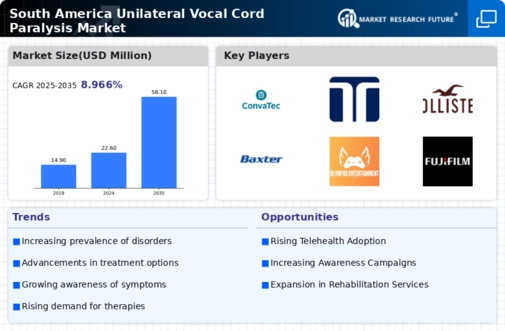Advancements in Surgical Techniques
Innovations in surgical techniques are significantly impacting the unilateral vocal-cord-paralysis market in South America. Minimally invasive procedures, such as endoscopic surgeries, have gained traction due to their reduced recovery times and lower complication rates. These advancements not only enhance patient outcomes but also increase the number of procedures performed annually. For instance, the introduction of robotic-assisted surgeries has shown promising results, with success rates exceeding 90% in certain cases. As surgical options become more effective and accessible, healthcare providers are likely to adopt these techniques more widely, thereby driving market growth. The potential for improved patient satisfaction and reduced healthcare costs further supports the expansion of this market segment.
Increasing Incidence of Vocal Cord Disorders
The rising incidence of vocal cord disorders in South America is a crucial driver for the unilateral vocal-cord-paralysis market. Factors such as environmental pollution, smoking, and occupational hazards contribute to this increase. Recent studies indicate that approximately 15% of the population in urban areas may experience some form of vocal cord dysfunction. This growing prevalence necessitates enhanced diagnostic and therapeutic options, thereby expanding the market. Healthcare providers are increasingly focusing on early detection and intervention strategies, which could lead to a surge in demand for specialized treatments. As awareness of vocal cord health improves, the market is likely to see a corresponding rise in the utilization of medical services and products aimed at managing unilateral vocal cord paralysis.
Enhanced Focus on Patient Education and Support
An enhanced focus on patient education and support is emerging as a significant driver for the unilateral vocal-cord-paralysis market in South America. Healthcare providers are increasingly recognizing the importance of informing patients about their conditions and available treatment options. Educational initiatives, workshops, and support groups are being established to empower patients and improve their understanding of vocal cord health. This proactive approach is likely to lead to earlier diagnosis and treatment, positively impacting market growth. Additionally, as patients become more informed, they may advocate for better healthcare services, further driving demand for specialized treatments. The emphasis on patient-centered care is expected to shape the future landscape of the unilateral vocal cord paralysis market.
Growing Investment in Healthcare Infrastructure
The increasing investment in healthcare infrastructure across South America is a pivotal driver for the unilateral vocal-cord-paralysis market. Governments and private entities are allocating substantial funds to enhance healthcare facilities, particularly in urban centers. This investment is expected to improve access to specialized care for vocal cord disorders. For example, the establishment of dedicated ENT clinics and rehabilitation centers is on the rise, which could lead to a more comprehensive approach to managing unilateral vocal cord paralysis. Furthermore, the integration of advanced diagnostic tools and treatment modalities is likely to enhance the overall quality of care. As healthcare systems evolve, the market is poised for growth, with an emphasis on patient-centered services.
Rising Demand for Non-Invasive Treatment Options
The unilateral vocal-cord-paralysis market is witnessing a growing demand for non-invasive treatment options in South America. Patients increasingly prefer therapies that minimize surgical risks and recovery times. Non-invasive interventions, such as voice therapy and the use of injectable materials for vocal cord augmentation, are gaining popularity. Recent surveys indicate that nearly 60% of patients express a preference for non-surgical alternatives when managing their condition. This trend is likely to drive innovation in treatment modalities, as healthcare providers seek to meet patient expectations. The market may also see an influx of new products designed to facilitate non-invasive management of unilateral vocal cord paralysis, further expanding treatment options available to patients.


















Leave a Comment